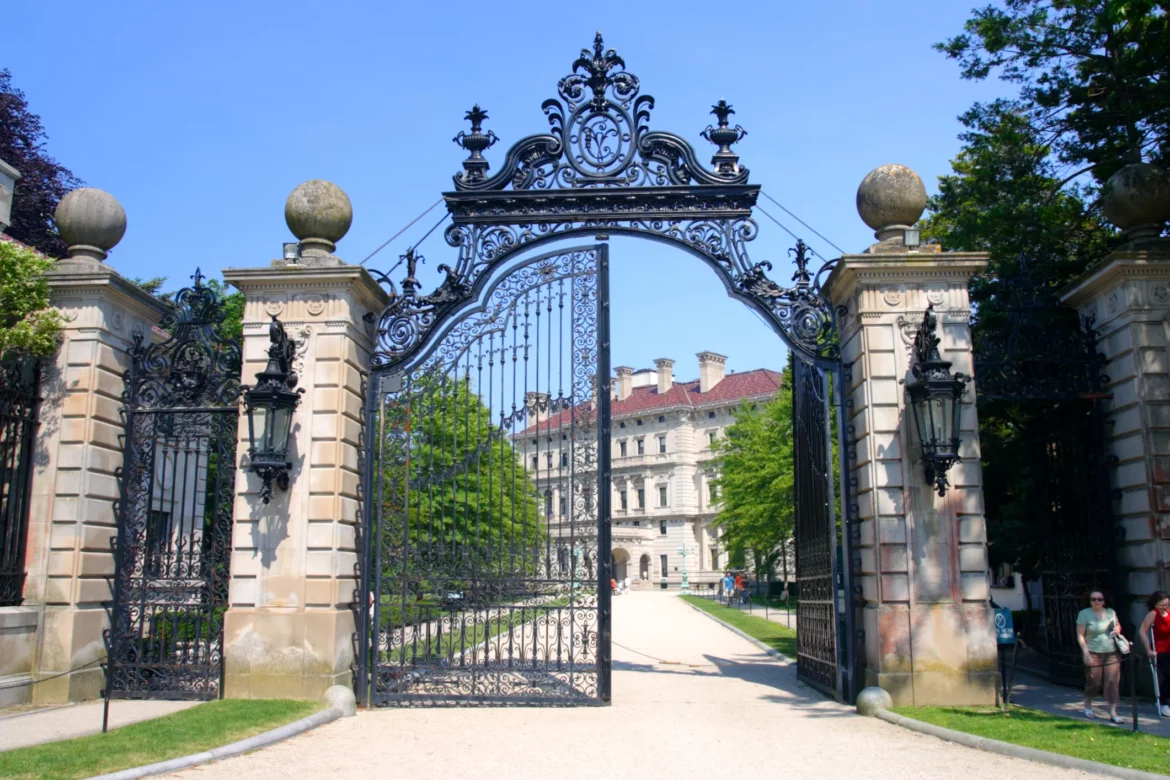This page may use affiliate links. When you click an affiliate link, we may get a small compensation at no cost to you. See Our Disclaimer and Affiliate Policy for more information.
Last Updated on January 8, 2024 by Ryan John
Nestled along the picturesque coastline of Rhode Island, Newport is renowned for its opulent mansions that harken back to the Gilded Age. These architectural masterpieces, once the summer homes of America’s elite, offer a glimpse into a bygone era of luxury, elegance, and grandeur. As you embark on a journey through Newport’s historic streets, each mansion tells a unique story of the families who lived there, the architects who designed them, and the events that shaped their legacy. From sprawling estates to manicured gardens, the Newport mansions are a testament to the city’s rich cultural heritage and architectural prowess.
- The Breakers: The Crown Jewel of the Newport Mansions
- The Elms: A French-Inspired Masterpiece in Newport
- Marble House: A Symbol of Newport’s Gilded Opulence
- Rosecliff: Newport’s Venue of Extravagance and Elegance
- Chateau-sur-Mer: Newport’s Victorian Architectural Gem
- Kingscote: Newport’s Pioneer of Summer “Cottages”
- Rough Point: Newport’s Secluded Gem
- Additional Properties
The Breakers: The Crown Jewel of the Newport Mansions
The Breakers stands as the epitome of Newport’s summer “cottages,” symbolizing the grandeur and opulence of the Gilded Age. Here’s a detailed look into the most iconic of the Newport mansions:
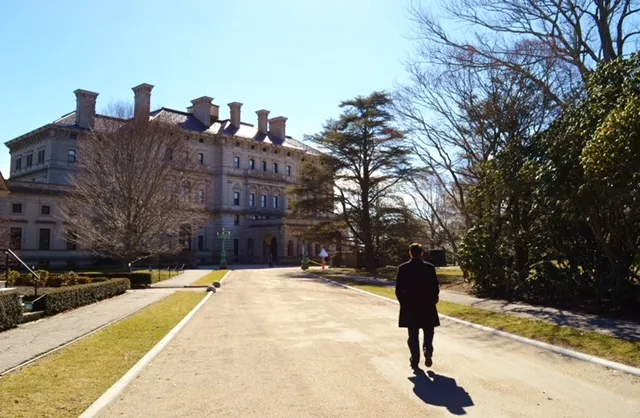
- History: The Breakers has a rich history that dates back to the late 19th century. Cornelius Vanderbilt II, a member of the wealthy Vanderbilt family, purchased the grounds in 1885 for $450,000 (equivalent to $14.7 million today). The original mansion on the property belonged to Pierre Lorillard IV. However, tragedy struck when it burned down on November 25, 1892. Determined to rebuild, Vanderbilt commissioned the famed architect Richard Morris Hunt to design a new mansion that would surpass its predecessor in splendor and luxury.
- Architecture: Designed by Richard Morris Hunt, The Breakers is a masterpiece of the Beaux Arts architectural style. The mansion boasts a lavish interior, intricate designs, and state-of-the-art amenities that were ahead of its time. Every corner of the mansion reflects the Vanderbilt family’s social and financial dominance during the Gilded Age.
- Significance: The Breakers is not just a mansion; it’s a symbol of the Vanderbilt family’s social and financial pre-eminence in the Gilded Age. The 13-acre property with its 70-room mansion has witnessed numerous events, celebrations, and gatherings, making it an integral part of Newport’s history.
- Legacy: The Breakers has seen various transformations over the years. In 2018, a significant event marked its history when the last of the Vanderbilt heirs moved out. However, the mansion’s legacy continues as it stands as a testament to the lavish lifestyles of America’s elite during the Gilded Age.
- Why Visit: A visit to The Breakers is like stepping back in time. The mansion offers a unique opportunity to experience the luxury, elegance, and opulence of the Gilded Age. From its stunning architecture to its rich history, The Breakers promises an unforgettable experience for history buffs, architecture enthusiasts, and anyone curious about the lifestyles of the rich and famous from yesteryears.
The Breakers is more than just a mansion; it’s a piece of history, a work of art, and a symbol of America’s Gilded Age. As you explore Newport’s collection of mansions, The Breakers undoubtedly stands out as the crown jewel of the Newport mansions, offering a glimpse into a bygone era of luxury and opulence. Whether you’re touring its lavish rooms, walking its manicured gardens, or simply admiring its architectural beauty, The Breakers promises a memorable experience that will leave you in awe.
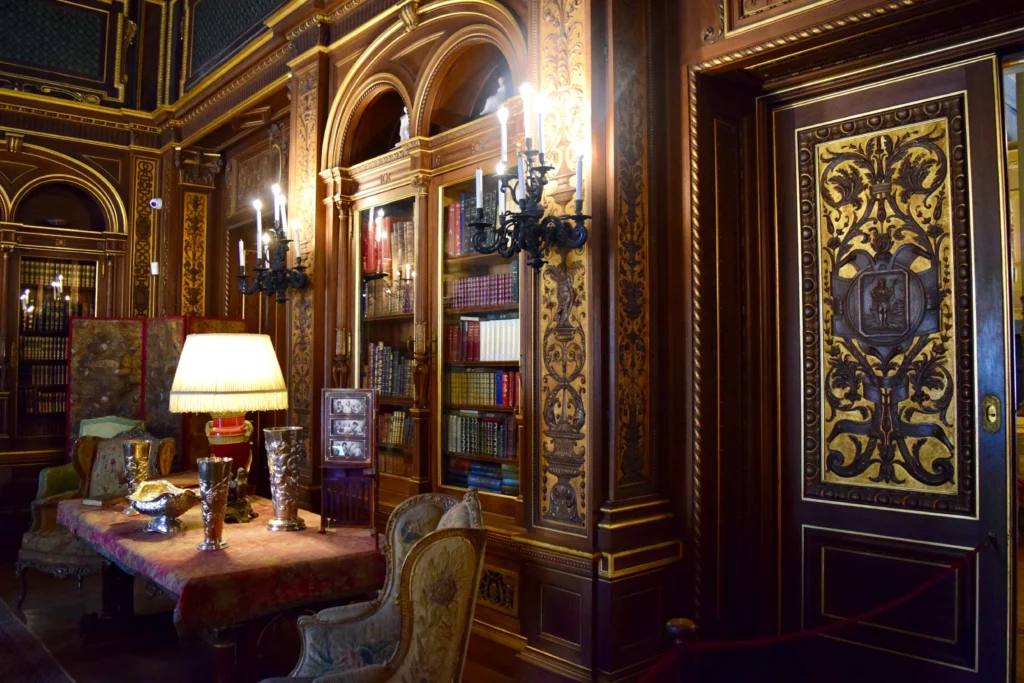
The Elms: A French-Inspired Masterpiece in Newport
The Elms, often referred to as a “summer cottage” in jest due to its grandeur, is one of Newport’s most exquisite mansions. Here’s an in-depth look into this architectural gem:
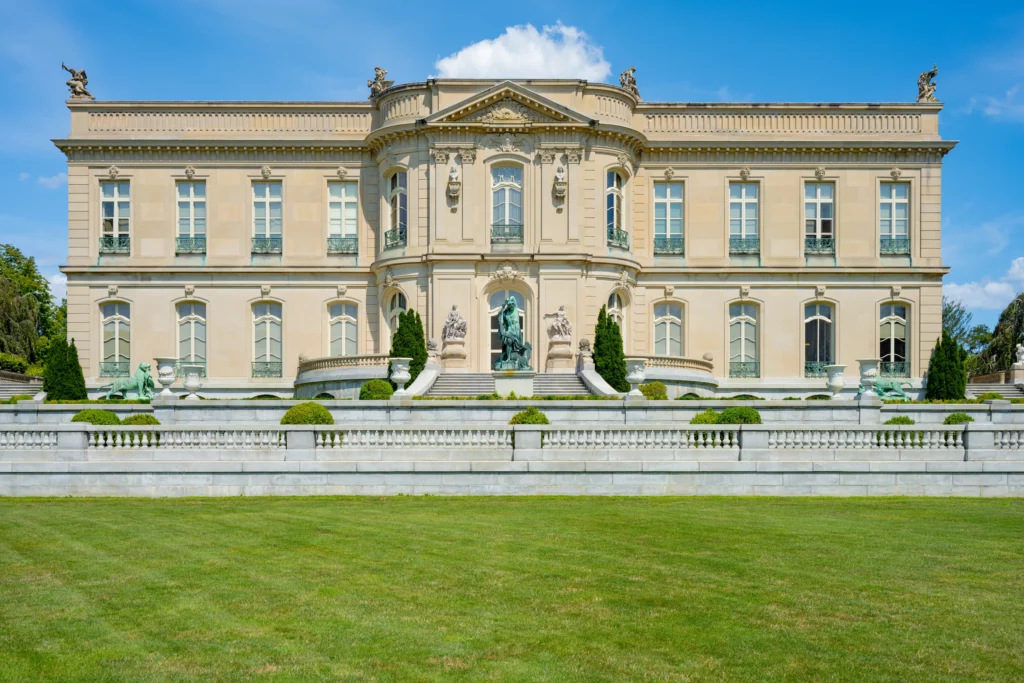
- History: The Elms was completed in 1901 and stands proudly at 367 Bellevue Avenue in Newport, Rhode Island. The Elms was commissioned by coal baron Edward Julius Berwind, who desired a residence that would reflect his wealth and taste.
- Architecture: The renowned architect Horace Trumbauer was tasked with designing The Elms. Taking inspiration from the 18th-century Château d’Asnières in Asnières-sur-Seine, France, Trumbauer created a mansion that seamlessly blended French chateau aesthetics with the modern amenities of the Gilded Age.
- Interiors: The Elms boasts an impressive collection of art, including paintings, statuary, and tapestries. The interiors are a testament to the opulence of the era, with intricate designs, lavish furnishings, and state-of-the-art technology for its time.
- Gardens and Exteriors: The landscape of The Elms is as captivating as its interiors. The mansion features formal gardens, terraces, pavilions, and fountains, offering a serene and picturesque setting that complements the grandeur of the building.
- Significance: Beyond its architectural beauty, The Elms played a pivotal role in Newport’s history. In 1962, The Elms was on the brink of being demolished. However, the Preservation Society of Newport County stepped in, acquiring the mansion and ensuring its legacy for future generations. This acquisition marked the beginning of the Preservation Society’s efforts to conserve the Newport mansions.
- Why Visit: A visit to The Elms offers a unique opportunity to experience the luxury and elegance of the Gilded Age. Touring the mansion provides insights into the lifestyles of America’s elite during this period. From its French-inspired architecture to its meticulously curated gardens, The Elms promises a memorable experience for history enthusiasts, architecture lovers, and anyone curious about the opulence of the past. It’s one of the premier properties of the Newport mansions.
Marble House: A Symbol of Newport’s Gilded Opulence
Marble House, one of the most impressive of the Newport mansions, stands as a testament to the lavishness and grandeur of the Gilded Age. Here’s a deep dive into this architectural marvel:
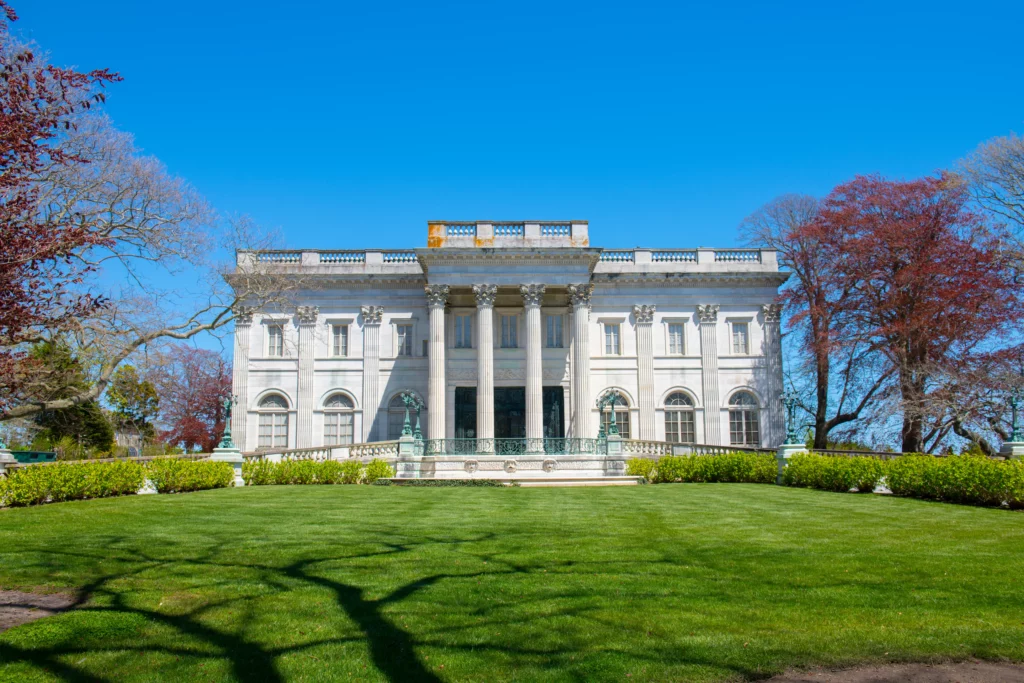
- History: Marble House was constructed between 1888 and 1892, serving as a summer residence for Alva and William Kissam Vanderbilt. Located at 596 Bellevue Avenue in Newport, Rhode Island, this mansion was designed by the esteemed architect Richard Morris Hunt. Interestingly, William Vanderbilt built Marble House as a 39th birthday present for his wife, Alva Vanderbilt, showcasing the immense wealth and status of the Vanderbilt family during this era.
- Architecture: Designed in the Beaux Arts style, Marble House is a masterpiece of architectural design and craftsmanship. The mansion’s name is derived from its extensive use of marble in both its interiors and exteriors, making it unparalleled in opulence for an American house when it was completed in 1892.
- Significance: Beyond its architectural beauty, Marble House played a pivotal role in Newport’s transformation from a quiet summer colony of wooden houses to the legendary resort of opulent Gilded Age mansions. The mansion set the pace for Newport’s subsequent architectural and social evolution, making it a significant landmark in the city’s history.
- Legacy: Marble House is not just a mansion; it’s a symbol of the Gilded Age’s extravagance and the Vanderbilt family’s prominence. Today, it stands as a National Historic Landmark, preserving its legacy for future generations and offering insights into the lifestyles of America’s elite during this fascinating period.
- Why Visit: A visit to Marble House offers a unique opportunity to experience the luxury, elegance, and opulence of the Gilded Age. Touring the mansion provides insights into the architectural innovations of the era, the refined tastes of the Vanderbilts, and the social dynamics of Newport’s high society. From its stunning marble-adorned interiors to its meticulously curated gardens, Marble House promises a memorable experience for history enthusiasts, architecture lovers, and anyone curious about the opulence of the past.It is part of the Newport mansions owned and operated by the Preservation Society.
Rosecliff: Newport’s Venue of Extravagance and Elegance
Rosecliff, one of the most distinguished of the Newport mansions, embodies the splendor and luxury of the Gilded Age. Let’s delve into the history and allure of this architectural masterpiece:
- History: Rosecliff was constructed between 1898 and 1902 for Theresa Fair Oelrichs, a silver heiress from Nevada. Her father, James Graham Fair, was one of the four partners in the Comstock Lode, a significant silver discovery in the United States. Theresa’s marriage to Hermann Oelrichs, the American agent for the Norddeutscher Lloyd steamship line, further elevated her social status.
- Architecture: The mansion’s design was inspired by the Grand Trianon, the garden retreat of French kings at Versailles. Esteemed architect Stanford White was responsible for bringing this vision to life, creating a mansion that seamlessly blended European elegance with American grandeur.
- Significance: Rosecliff has been the venue for many of Newport’s most lavish Gilded Age parties and events. The mansion’s grand ballroom, opulent interiors, and picturesque gardens made it the ideal setting for the elite’s extravagant celebrations.
- Legacy: Over the years, Rosecliff has undergone various transformations to preserve its beauty and historical significance. Notably, the mansion recently underwent an extensive $7.4 million renovation, ensuring that its legacy continues for future generations.
- Why Visit: A tour of Rosecliff offers visitors a unique opportunity to step back in time and experience the opulence of the Gilded Age. From its grand ballroom to its meticulously curated gardens, Rosecliff promises a memorable experience. The mansion also provides insights into the lives of America’s elite during this era, showcasing the influence of European architecture on American designs and the lavish lifestyles of Newport’s high society. It is arguably the most interesting of the Newport mansions thanks to its use in film and availability to host events and weddings.
Rosecliff stands as a beacon of Newport’s rich history and the architectural innovations of the Gilded Age. Rosecliff, with its blend of European elegance and American luxury, is sure to captivate your senses. Whether you’re wandering through its lavish rooms, attending an event in its grand ballroom, or simply admiring its architectural beauty, the Rosecliff is sure to leave you in awe and make you eager to visit other Newport mansions.
Chateau-sur-Mer: Newport’s Victorian Architectural Gem
Chateau-sur-Mer stands as one of Newport’s earliest and most impressive examples of the grand mansions that would come to define the city’s Gilded Age. Here’s an exploration of this historic mansion:
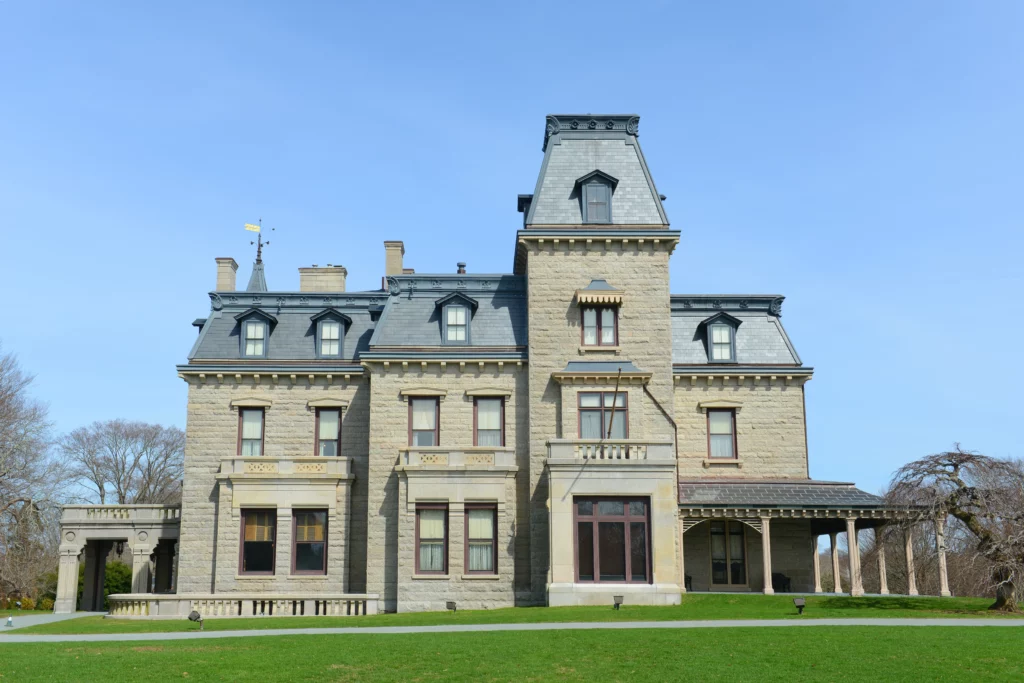
- History: Chateau-sur-Mer is one of the first grand mansions on Bellevue Avenue, marking the dawn of Newport’s Gilded Age. Before the appearance of the Vanderbilt houses in the 1890s, Chateau-sur-Mer was considered the most palatial residence in Newport.
- Architecture: Built in 1852, Chateau-sur-Mer epitomizes High Victorian architecture. Its design showcases a blend of European elegance and American craftsmanship, with intricate woodwork, wallpapers, ceramics, and stenciling that reflect the opulence of the era.
- Significance: Chateau-sur-Mer played a pivotal role in ushering in Newport’s Gilded Age. Its grand scale and lavish parties set the standard for the extravagant events and residences that would come to define Newport’s high society in the late 19th century.
- Legacy: Recognizing its historical and architectural significance, the Preservation Society of Newport County acquired Chateau-sur-Mer in 1966. The mansion was subsequently listed in the National Register of Historic Places in 1968. The Preservation Society has since undertaken significant restoration efforts, including a multi-million dollar restoration of the mansion’s roof, ensuring that Chateau-sur-Mer’s legacy continues for future generations.
- Why Visit: A visit to Chateau-sur-Mer offers a unique opportunity to experience the luxury and elegance of Newport’s early Gilded Age. Touring the mansion provides insights into the architectural innovations of the era, the refined tastes of Newport’s elite, and the social dynamics of the city’s high society. From its stunning interiors to its meticulously curated gardens, Chateau-sur-Mer promises a memorable experience for history enthusiasts, architecture lovers, and anyone curious about the opulence of the past.
Kingscote: Newport’s Pioneer of Summer “Cottages”
Kingscote, with its distinctive Gothic Revival architecture, stands as one of Newport’s earliest and most significant summer residences. Here’s a closer look at this historic mansion:
- History: Kingscote was constructed in 1839, making it one of the first summer “cottages” in Newport. This early establishment set the stage for the numerous grand mansions that would later define Newport’s Gilded Age.
- Architecture: The mansion was designed by the renowned architect Richard Upjohn. Its Gothic Revival style is evident in its intricate designs, pointed arches, and ornate woodwork. The mansion’s architecture is a testament to the evolving tastes and styles of the era, blending European influences with American craftsmanship.
- Significance: Kingscote’s significance lies not just in its architectural beauty but also in its pioneering role in Newport’s history. Before the grandeur of the Vanderbilt houses and other opulent residences of the late 19th century, Kingscote marked the beginning of Newport’s transformation into a summer retreat for America’s elite.
- Legacy: Recognizing its historical and architectural importance, Kingscote was designated a National Historic Landmark. This recognition ensures that the mansion’s legacy is preserved for future generations, offering insights into Newport’s early days as a summer resort for the wealthy.
- Why Visit: A tour of Kingscote offers a unique opportunity to experience the charm and elegance of Newport’s early summer residences. Visitors can explore the mansion’s lavish rooms, admire its architectural details, and learn about the social dynamics of Newport’s high society in the early 19th century. From its stunning interiors to its meticulously curated gardens, Kingscote promises a memorable experience for history enthusiasts, architecture lovers, and anyone curious about the opulence of the past.
Rough Point: Newport’s Secluded Gem
Rough Point, perched on a dramatic, windswept promontory along Newport’s famous Cliff Walk, offers a unique blend of history, architecture, and stunning ocean views. Unlike the rest of the Newport mansions on this list, this is not a part of the Newport Preservation Society. Here’s a closer look at this remarkable mansion:
- History: Rough Point was constructed in 1889 by Frederick W. Vanderbilt, a member of the influential Vanderbilt family. The mansion later became the summer home of Doris Duke, the tobacco heiress and philanthropist, who was known for her reclusive nature and immense wealth. Doris Duke’s love for Newport was evident, as she summered at Rough Point for many years. After her passing in 1993, the mansion underwent legal proceedings and was eventually opened to the public in 2000.
- Architecture: The mansion boasts a vast English Manorial house design, reflecting the architectural tastes and styles of the era. Its location on Newport’s Cliff Walk offers panoramic views of the Atlantic Ocean, making it a picturesque setting that complements the grandeur of the building.
- Significance: Beyond its architectural beauty, Rough Point holds a special place in Newport’s history. The mansion has witnessed numerous events, celebrations, and gatherings, making it an integral part of Newport’s social tapestry.
- Legacy: Unlike many of Newport’s mansions, Rough Point is not part of the Newport Preservation Society. Instead, it is managed by the Newport Restoration Foundation, ensuring that the mansion’s legacy is preserved for future generations. This distinction offers visitors a unique perspective on Newport’s history and the lives of its elite residents.
- Why Visit: A visit to Rough Point offers a unique opportunity to experience the luxury and elegance of Newport’s Gilded Age. Touring the mansion provides insights into the architectural innovations of the era, the refined tastes of Newport’s elite, and the social dynamics of the city’s high society. From its stunning interiors to its meticulously curated gardens, Rough Point promises a memorable experience for history enthusiasts, architecture lovers, and anyone curious about the opulence of the past.
Additional Properties
A brief overview of the additional properties owned by the Newport Preservation Society, in addition to the Newport mansions listed above:
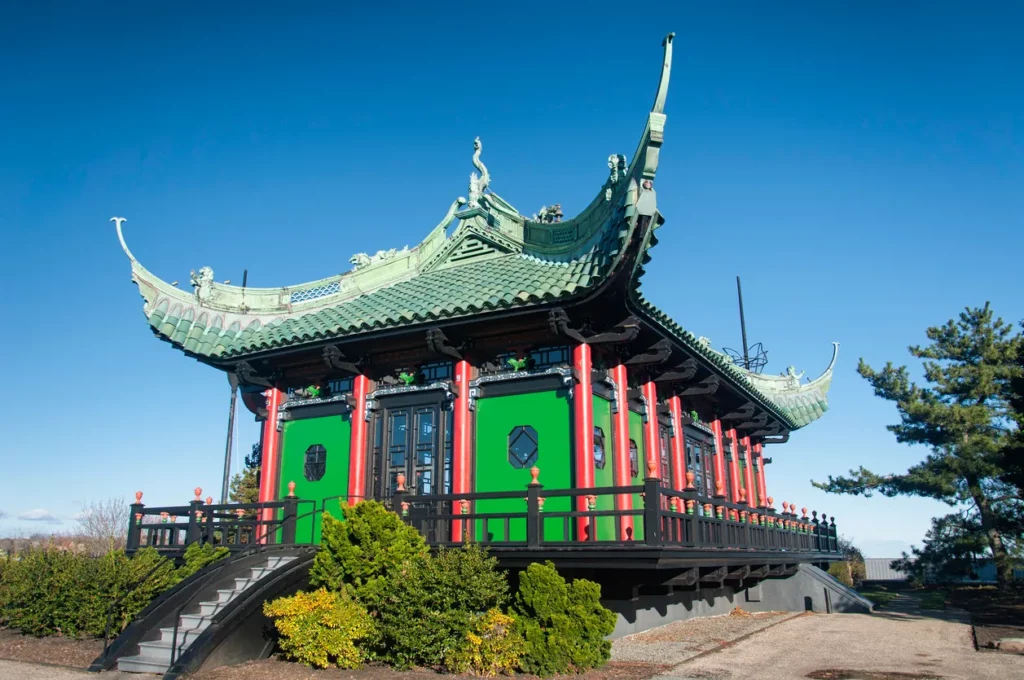
- Chinese Tea House: Located on the grounds of Marble House, the Chinese Tea House is a unique structure that reflects Alva Vanderbilt’s interest in Asian art and culture. It was used as a setting for her suffragette rallies and offers stunning views of the Cliff Walk and the Atlantic Ocean. It’s available for rehearsal dinner rentals, making it one of the few spaces available that are a part of the Newport mansions.
- Isaac Bell House: Built in 1883, the Isaac Bell House is an exceptional example of the Shingle Style of architecture. It combines elements of colonial New England architecture with the modern aesthetic and open floor plans of the late 19th century.
- Green Animals Topiary Garden: Located in Portsmouth, this is the oldest and most northern topiary garden in the United States. It features over 80 pieces of topiary, including animals, birds, and geometric figures, all sculpted from California privet, yew, and English boxwood.
- Hunter House: A fine example of Georgian Colonial architecture, Hunter House is one of the oldest surviving houses in Newport. It showcases exquisite woodwork, period furniture, and a collection of 18th-century Newport furniture, making it a must-visit for history and architecture enthusiasts.
- Chepstow: Built in 1860, Chepstow is an Italianate-style villa that offers a glimpse into the aesthetic and cultural values of the 19th century. The house showcases a collection of furniture, paintings, and decorative arts from the Colonial era to the Gilded Age.
- The Breakers Stable & Carriage House: Located approximately half a mile west of The Breakers, this property was built in 1895 and is a testament to the Vanderbilt family’s love for horses and carriages. The building houses an exhibit on the New York Central Railroad, which was owned by the Vanderbilts, and showcases various carriages and early automobiles.


